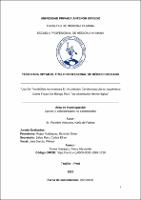Uso de trombólisis intravenosa en accidentes cerebrovasculares isquémicos como factor de riesgo para transformación hemorrágica

View/
Download
(application/pdf: 779.6Kb)
(application/pdf: 779.6Kb)
Date
2021Author(s)
Paredes Anticona, Karla de Fatima
Metadata
Show full item recordAbstract
Objetivo: Demostrar si el uso de trombólisis intravenosa en pacientes con
accidente cerebrovascular isquémico es un factor de riesgo para
transformación hemorrágica.
Materiales y Métodos: Se llevó a cabo un estudio observacional,
longitudinal, cohorte retrospectiva en pacientes que padecieron accidente
cerebrovascular isquémico en el Hospital Víctor Lazarte Echegaray, se
revisaron historias clínicas entre los años 2013 -2017, se obtuvieron 96
pacientes con edades entre 40 – 80 años. La variable exposición fue
trombólisis intravenosa y la variable resultado fue transformación
hemorrágica.
Resultados: De la totalidad de pacientes trombolizados, que fueron 24
pacientes, el 42% de ellos presento transformación hemorrágica, donde
el análisis estadístico demostró la asociación entre trombólisis
intravenosa y transformación hemorrágica. (RR = 4.34 [1.53-12.32]; p<
0.05). De todas las variables intervinientes, el uso de válvula mecánica se
relacionó con significancia a estos resultados. (RR=10.65 [1.41-80.37]; p<
0.05).
Conclusiones: El uso de trombólisis intravenosa en pacientes con
accidentes cerebrovasculares isquémicos es un factor de riesgo para
transformación hemorrágica. Objective: Demonstrate the use of intravenous thrombolysis in patients
with acute ischemic stroke is a risk factor for hemorrhagic transformation.
Materials and Methods: An observational, longitudinal, retrospective
cohort study was carried out in patients suffering from ischemic stroke at
the Víctor Lazarte Echegaray Hospital, clinical records were reviewed
between 2013-2017, 96 patients were obtained between the ages of 40-
80 years. The exposure variable was intravenous thrombolysis and the
outcome variable was hemorrhagic transformation.
Results: Of all the thrombolized patients, which were 24 patients, 42% of
them presented hemorrhagic transformation, where the statistical analysis
showed the association between intravenous thrombolysis and
hemorrhagic transformation. (RR = 4.34 [1.53-12.32]; p <0.05). Of all the
intervening variables, the use of mechanical valve was related to
significance to these results. (RR = 10.65 [1.41-80.37]; p <0.05)
Conclusions: The use of intravenous thrombolysis in patients with
ischemic strokes is a risk factor for hermorrhagic transformation.
Collections
- Medicina Humana [2969]

